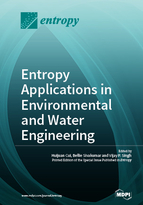Entropy Applications in Environmental and Water Engineering
A special issue of Entropy (ISSN 1099-4300).
Deadline for manuscript submissions: closed (22 December 2017) | Viewed by 137135
Special Issue Editors
Interests: streamflow forecasting; hydrological time series analysis; entropy-based modeling; velocity distribution; sediment discharge
Special Issues, Collections and Topics in MDPI journals
Interests: hydrologic modeling; climate change impacts; large-scale water projects; sediment transport; complex systems; nonlinear dynamics and chaos; fractals; complex networks
Special Issues, Collections and Topics in MDPI journals
Interests: hydrology; water resources engineering; water quality modeling; environmental management; climate change impacts; entropy-based modeling; copula-based modeling
Special Issues, Collections and Topics in MDPI journals
Special Issue Information
Dear Colleagues,
Entropy theory has found applications in a wide range of problems in the field of environmental and water engineering, including river hydraulic geometry, fluvial hydraulics, water monitoring network design, river flow forecasting, floods and droughts, river network analysis, infiltration, soil moisture, sediment transport, surface water and groundwater quality modeling, ecosystems modeling, water distribution networks, environmental and water resources management, and parameter estimation. Such applications have also used several different entropy formulations, such as the Shannon, Tsallis, Rényi, Burg, Kolmogorov, Kapur, configurational, and relative entropies, which can be derived in time, space or frequency domain. More recently, entropy-based concepts have been coupled with other theories, including copula and wavelets, to study various issues associated with environmental and water resources’ systems. Recent and current research clearly indicate the enormous scope and potential of entropy theory in advancing research in the field of environmental and water engineering, including establishing and explaining physical connections between theory and reality.
The aim of this Special Issue is to provide a platform for compiling important recent and current research on the applications of entropy theory in environmental and water engineering. Manuscripts that address any and all aspects associated with entropy theory applications in environmental and water engineering are welcome. Manuscripts that attempt integration of entropy theory with other concepts and those that address general and large-scale issues in environmental and water engineering are particularly encouraged.
Dr. Huijuan Cui
Prof. Bellie Sivakumar
Prof. Vijay P. Singh
Guest Editors
Manuscript Submission Information
Manuscripts should be submitted online at www.mdpi.com by registering and logging in to this website. Once you are registered, click here to go to the submission form. Manuscripts can be submitted until the deadline. All submissions that pass pre-check are peer-reviewed. Accepted papers will be published continuously in the journal (as soon as accepted) and will be listed together on the special issue website. Research articles, review articles as well as short communications are invited. For planned papers, a title and short abstract (about 100 words) can be sent to the Editorial Office for announcement on this website.
Submitted manuscripts should not have been published previously, nor be under consideration for publication elsewhere (except conference proceedings papers). All manuscripts are thoroughly refereed through a single-blind peer-review process. A guide for authors and other relevant information for submission of manuscripts is available on the Instructions for Authors page. Entropy is an international peer-reviewed open access monthly journal published by MDPI.
Please visit the Instructions for Authors page before submitting a manuscript. The Article Processing Charge (APC) for publication in this open access journal is 2600 CHF (Swiss Francs). Submitted papers should be well formatted and use good English. Authors may use MDPI's English editing service prior to publication or during author revisions.
Keywords
- Entropy theory
- complex systems
- hydraulics
- hydrology
- water engineering
- environmental engineering
Related Special Issue
- Entropy Applications in Environmental and Water Engineering II in Entropy (20 articles)








